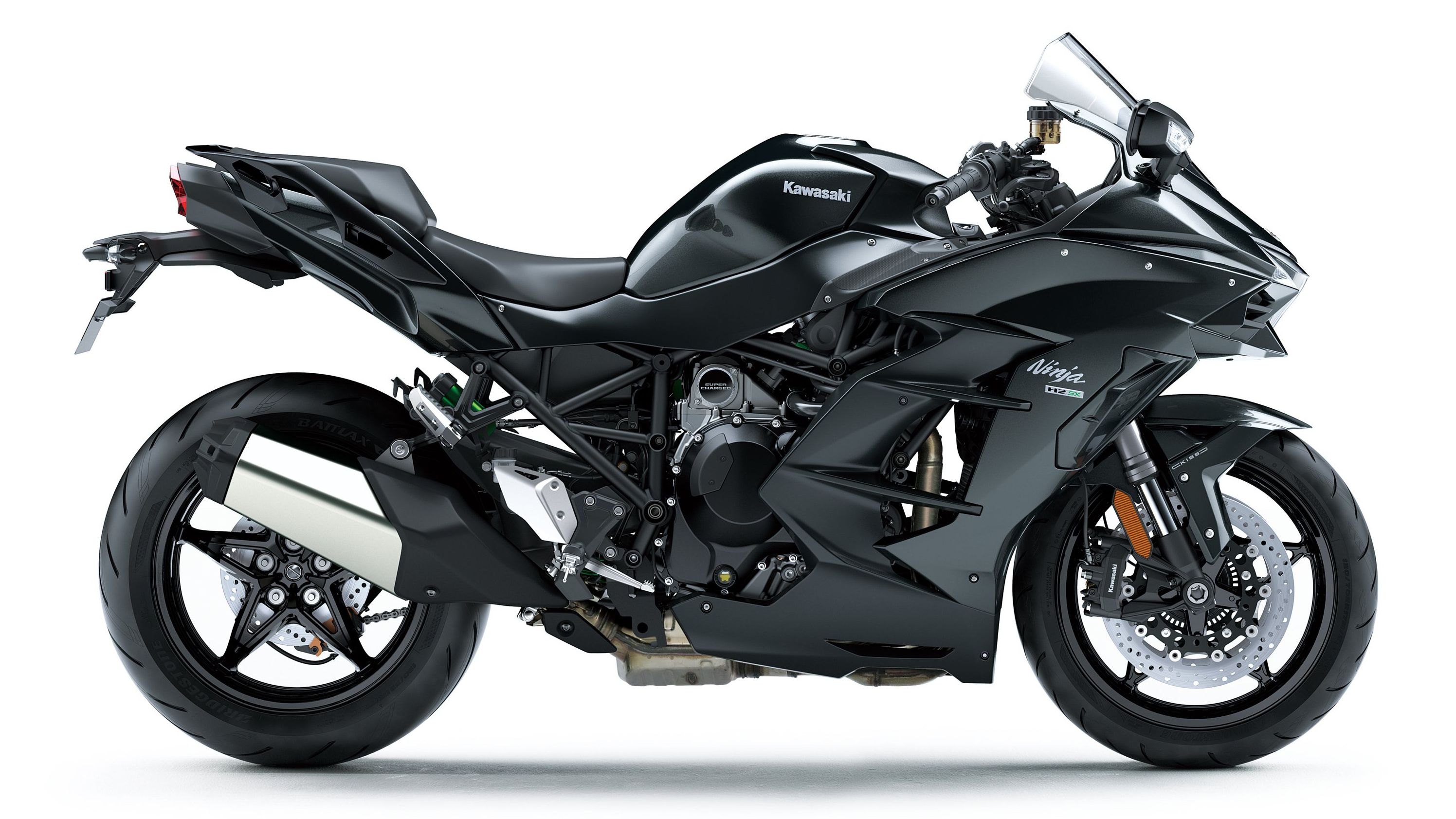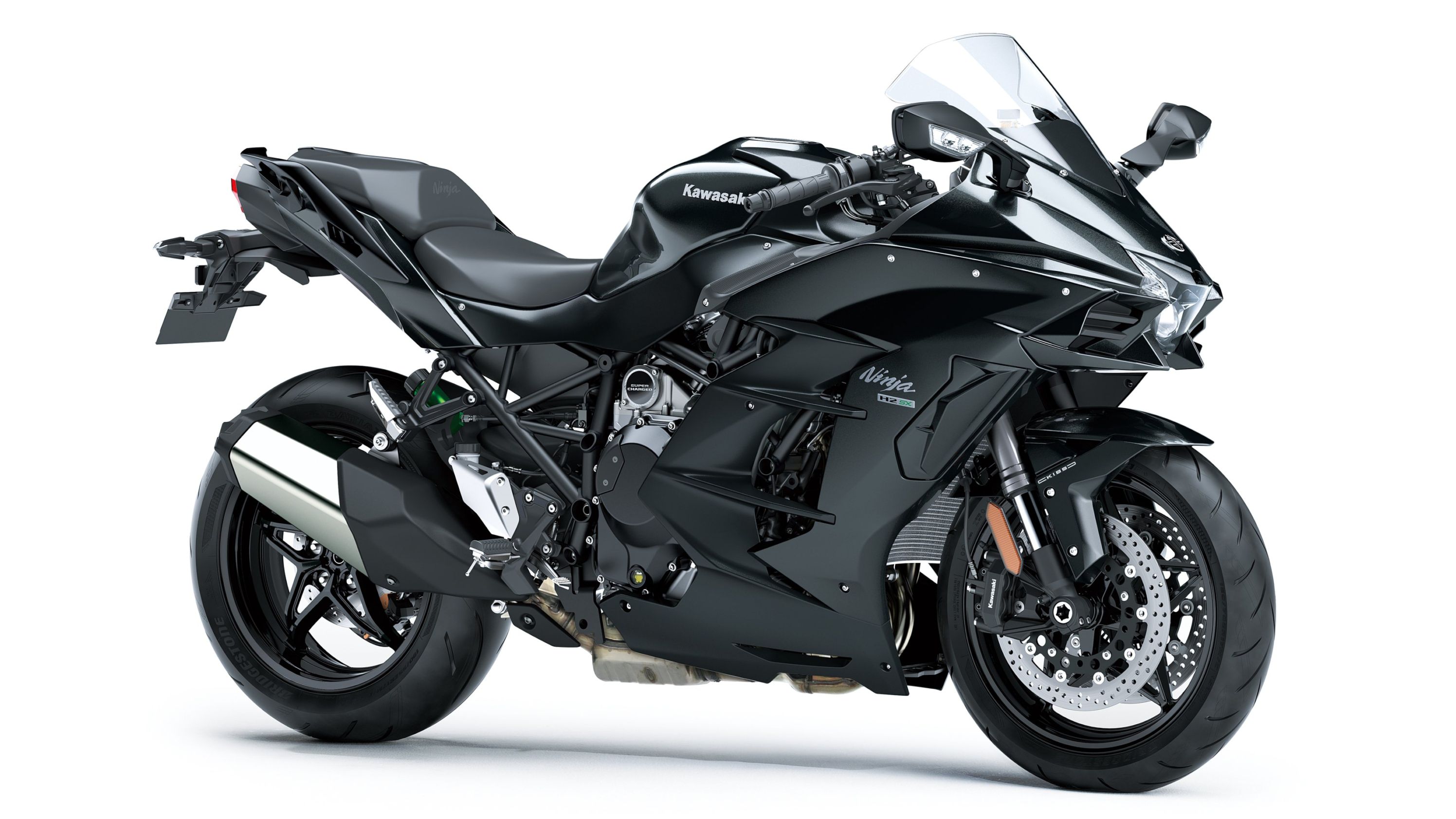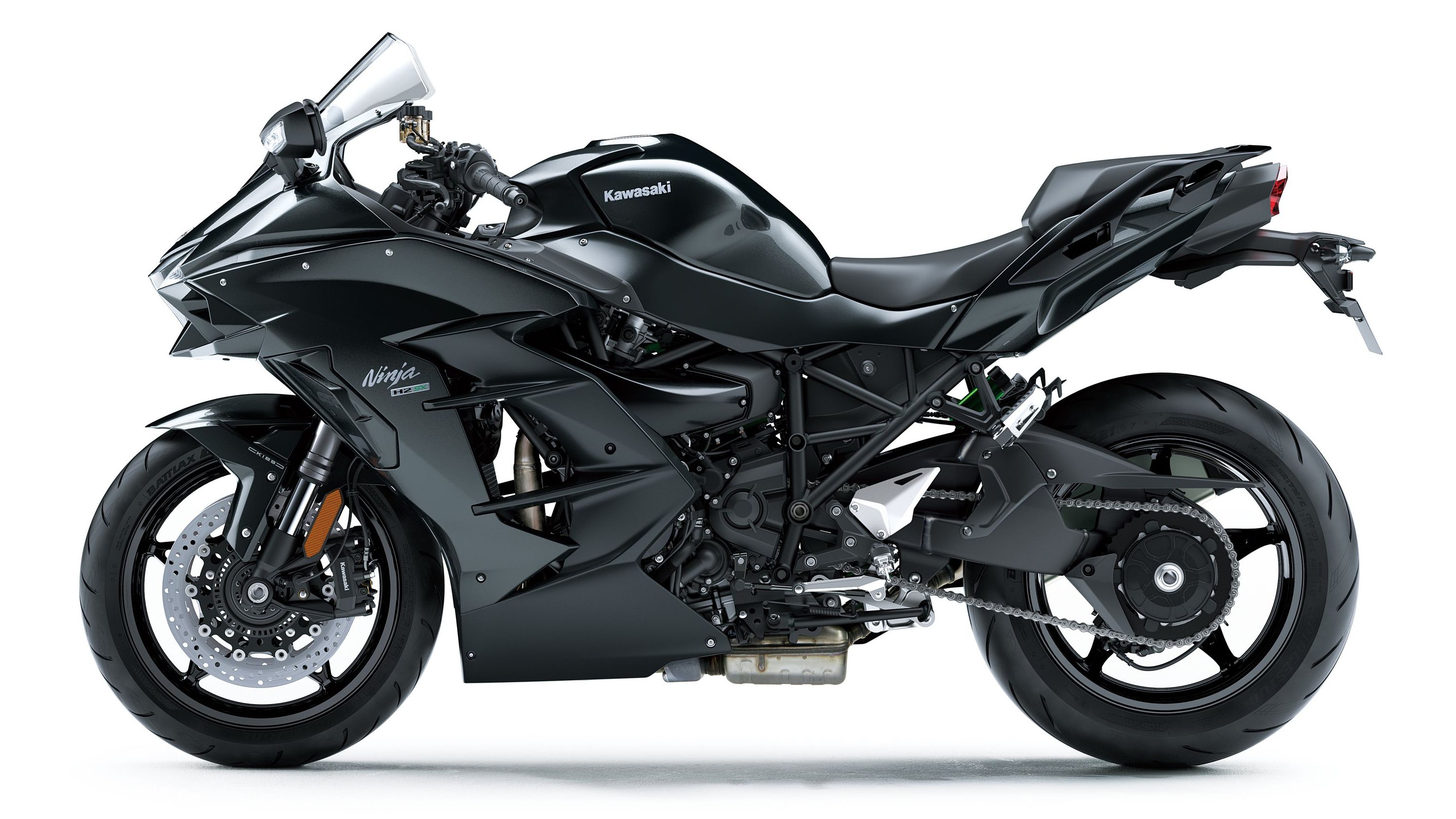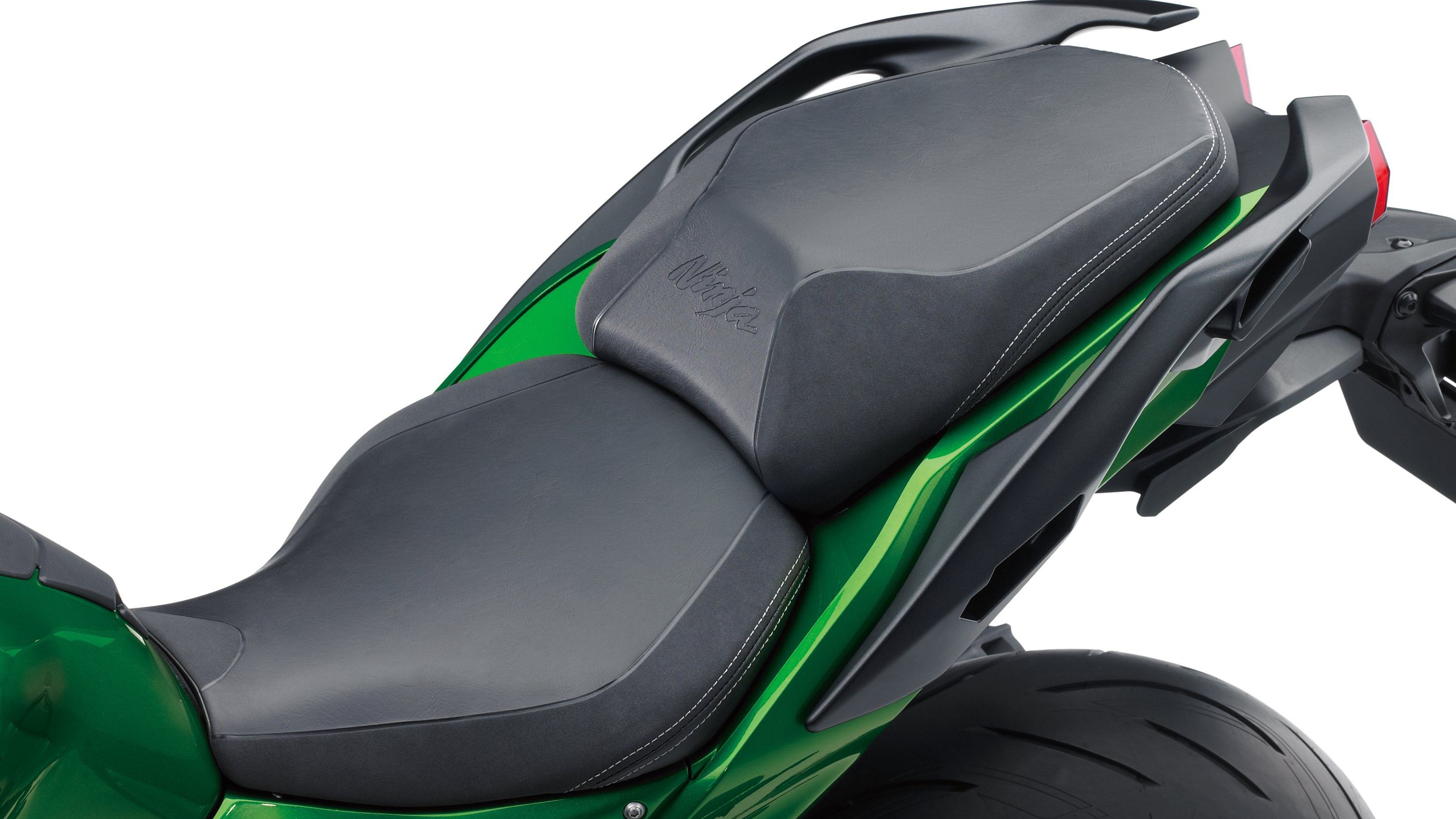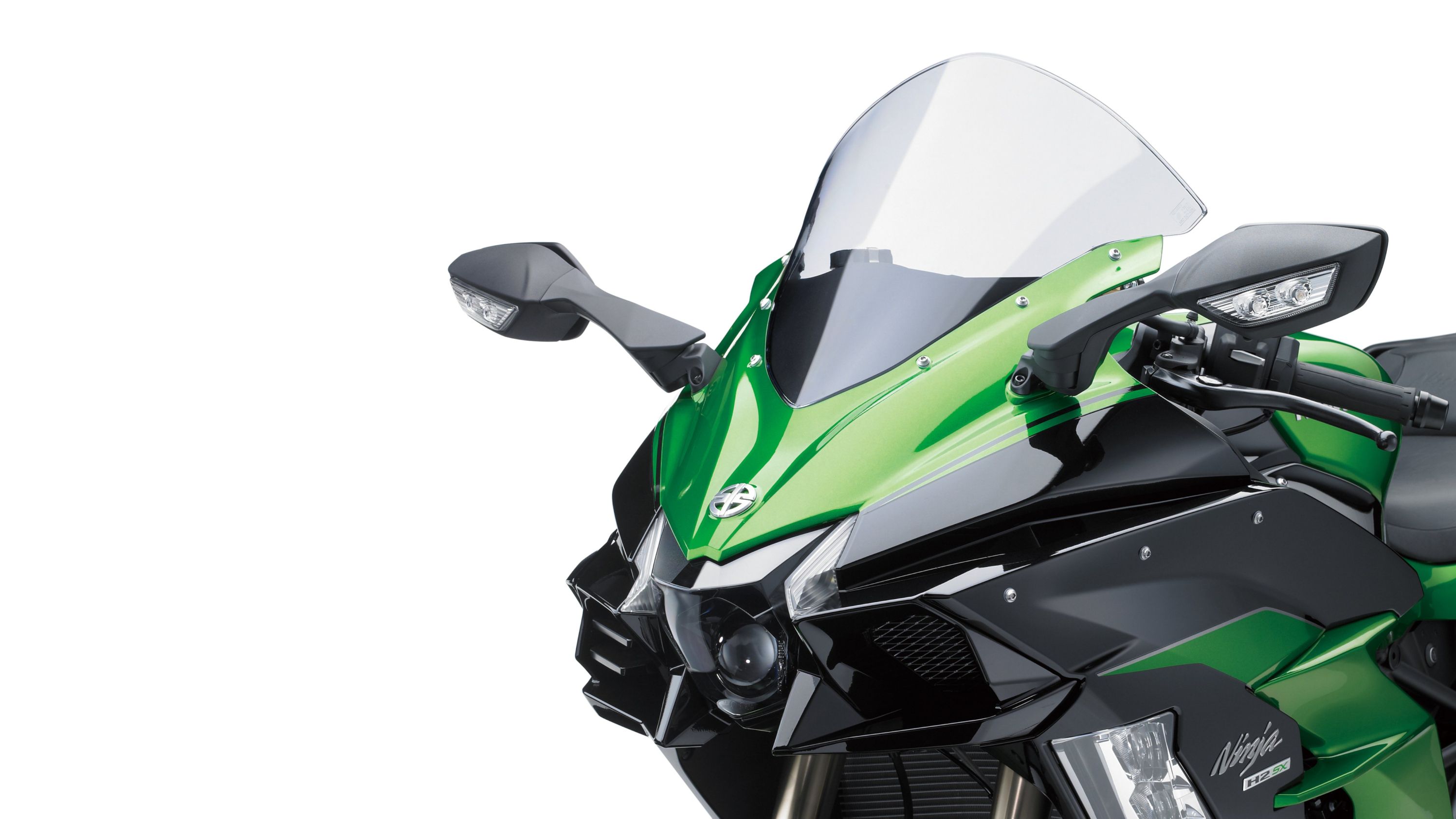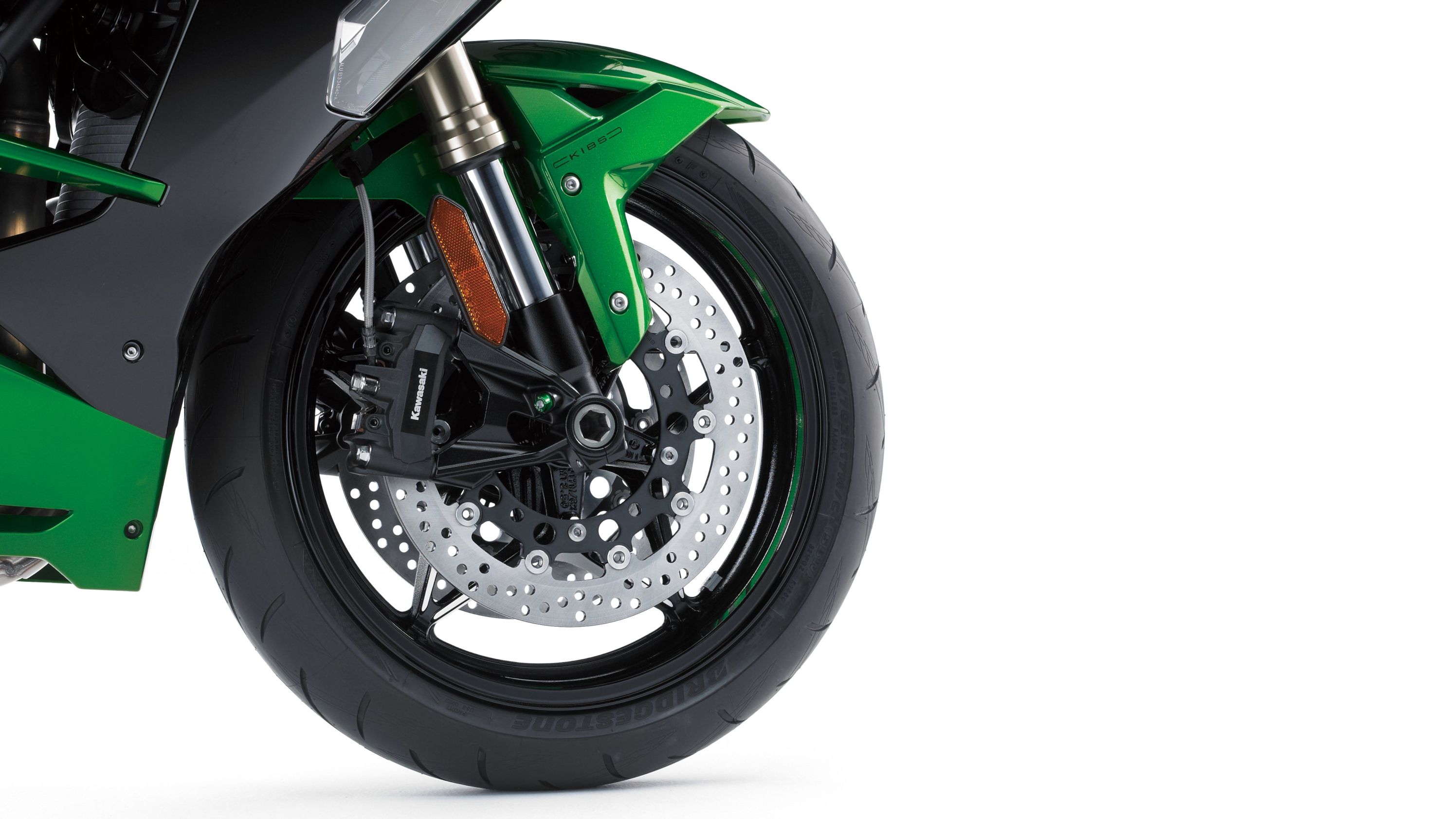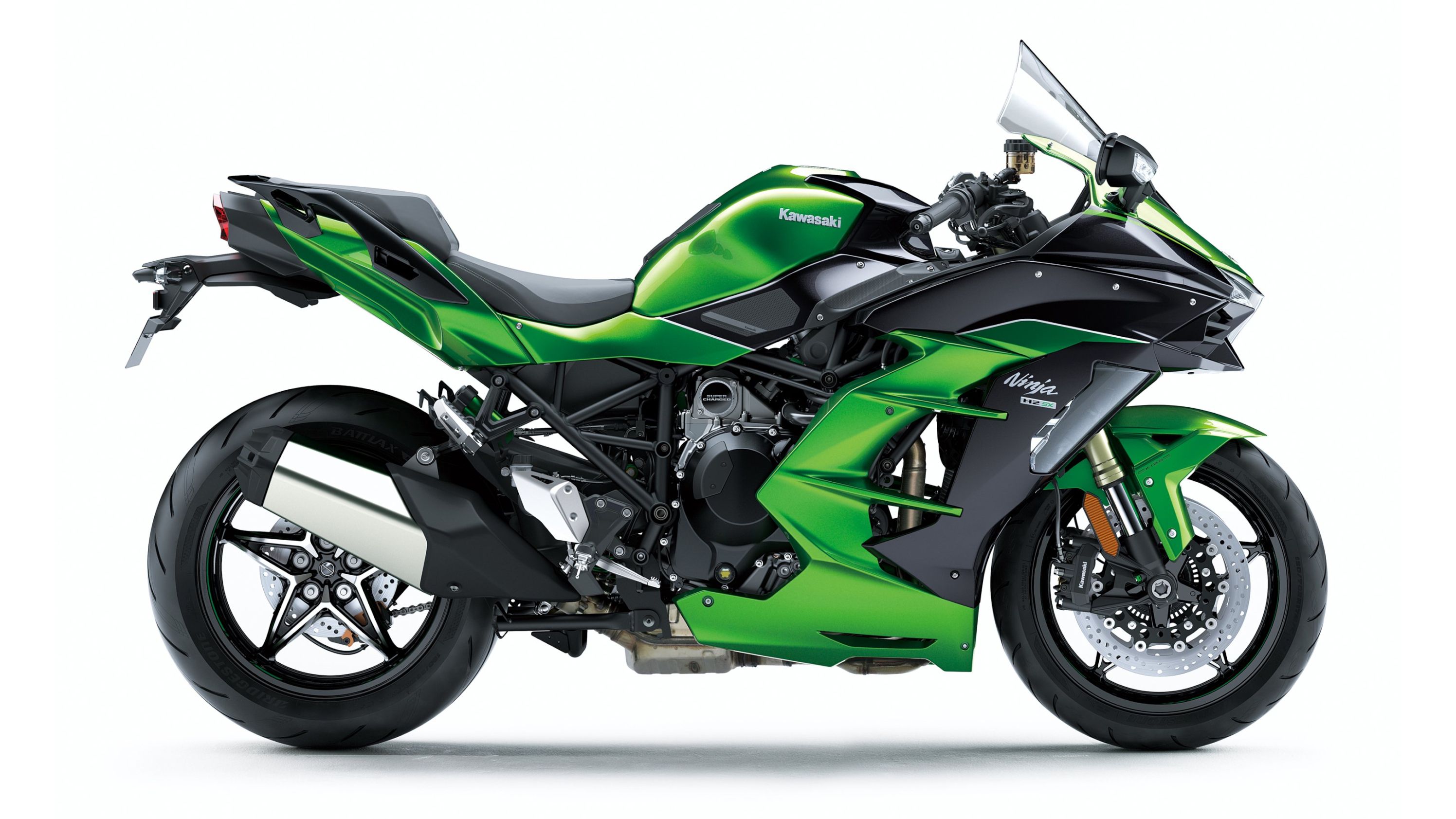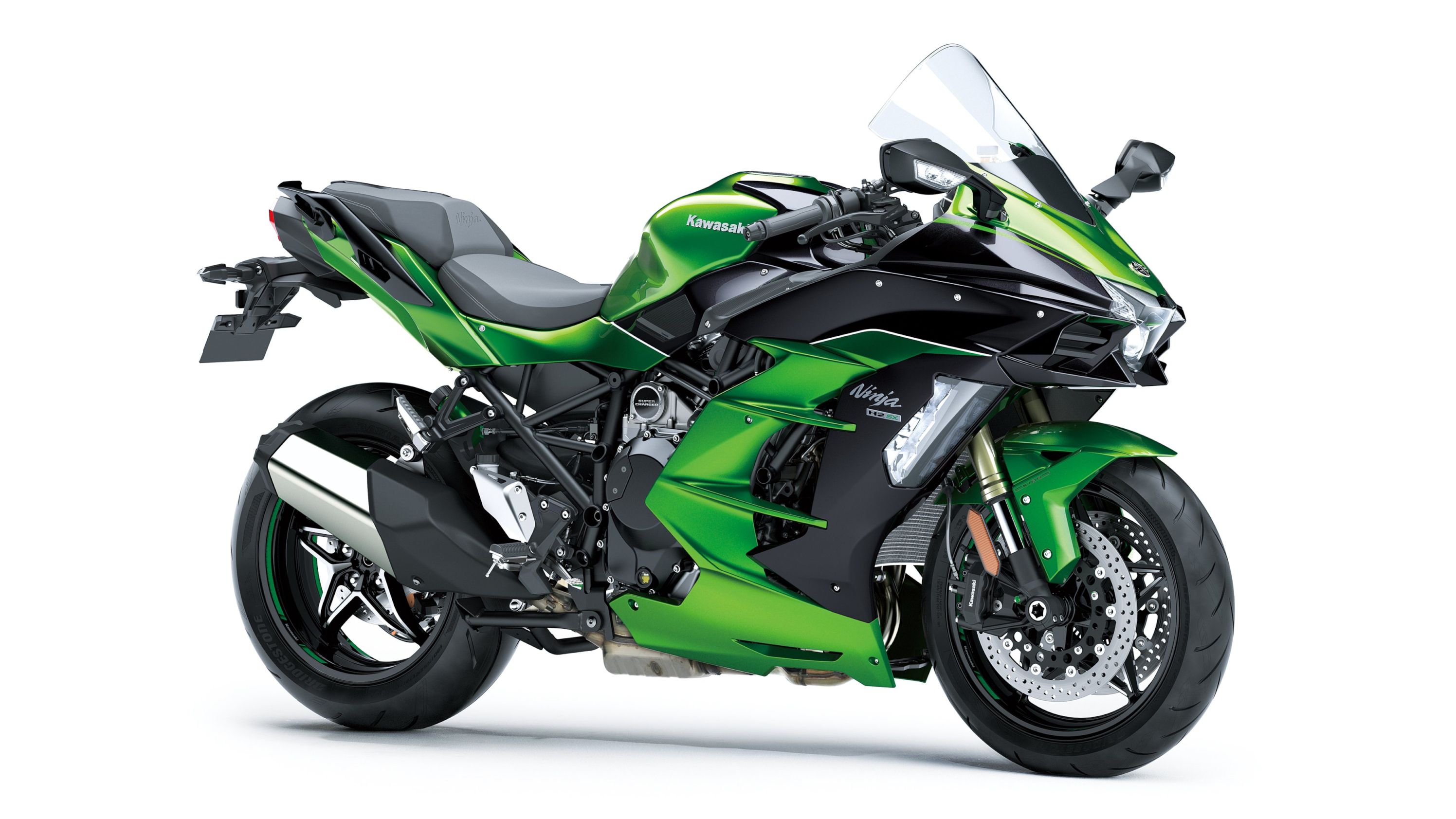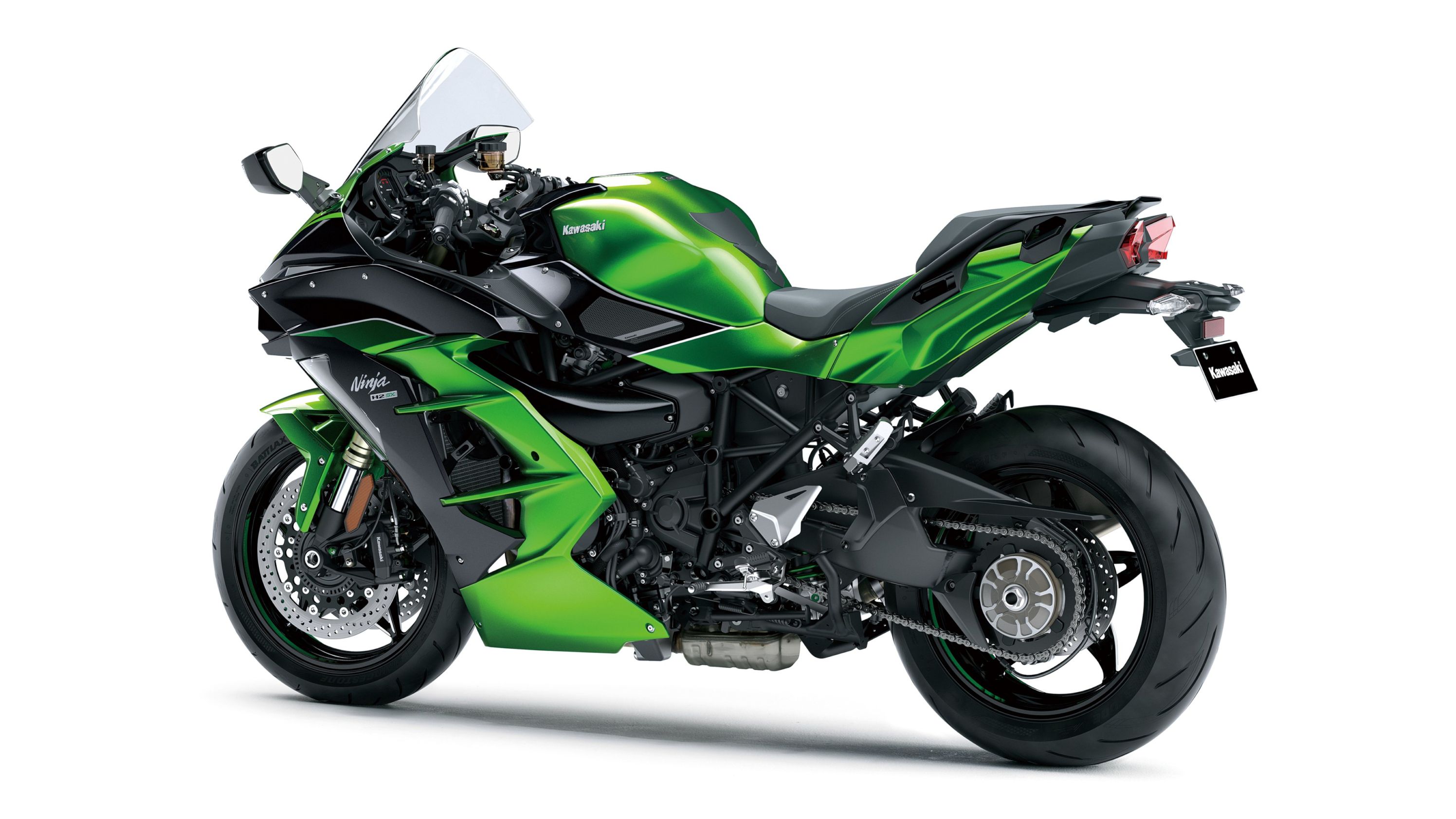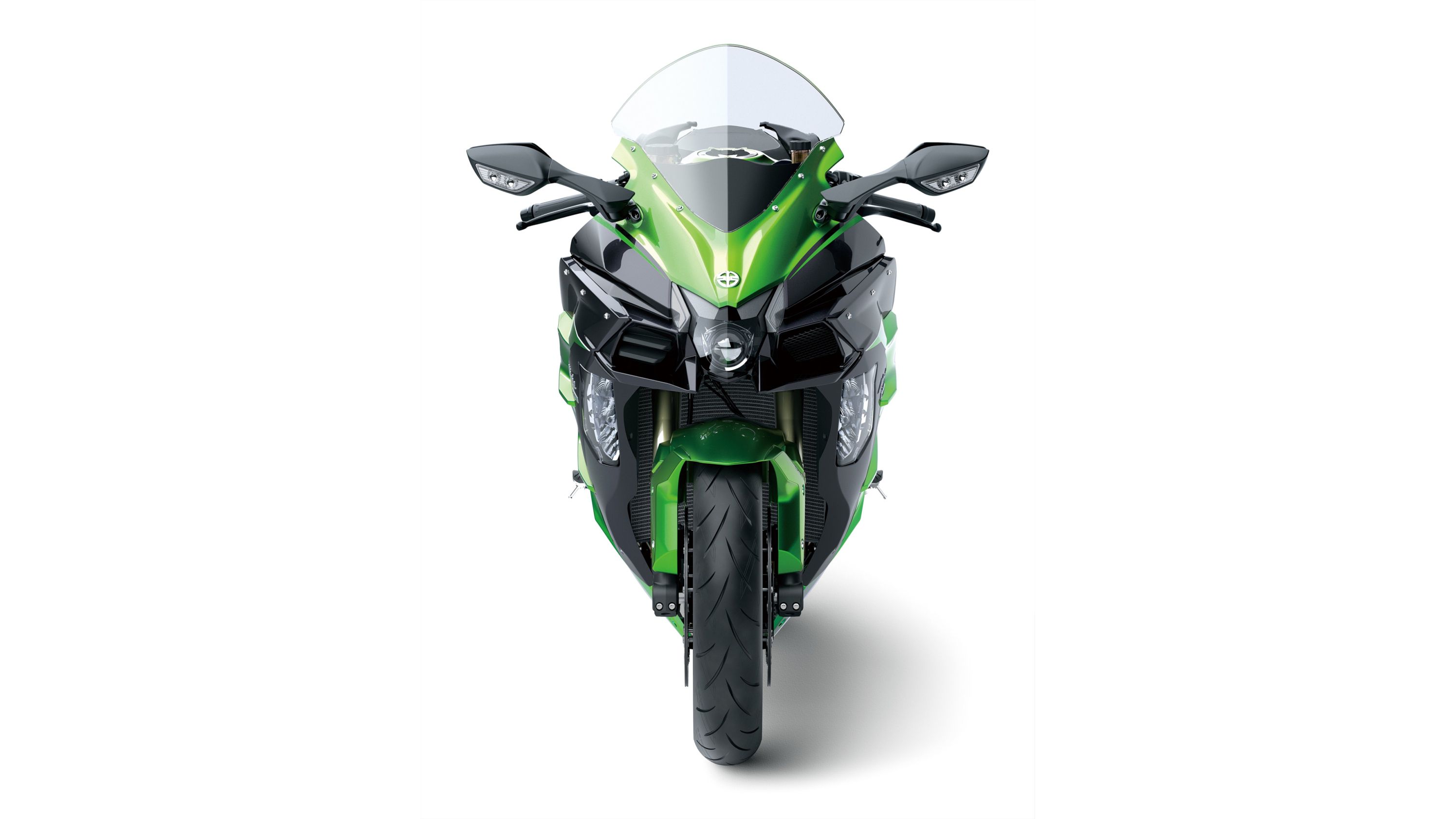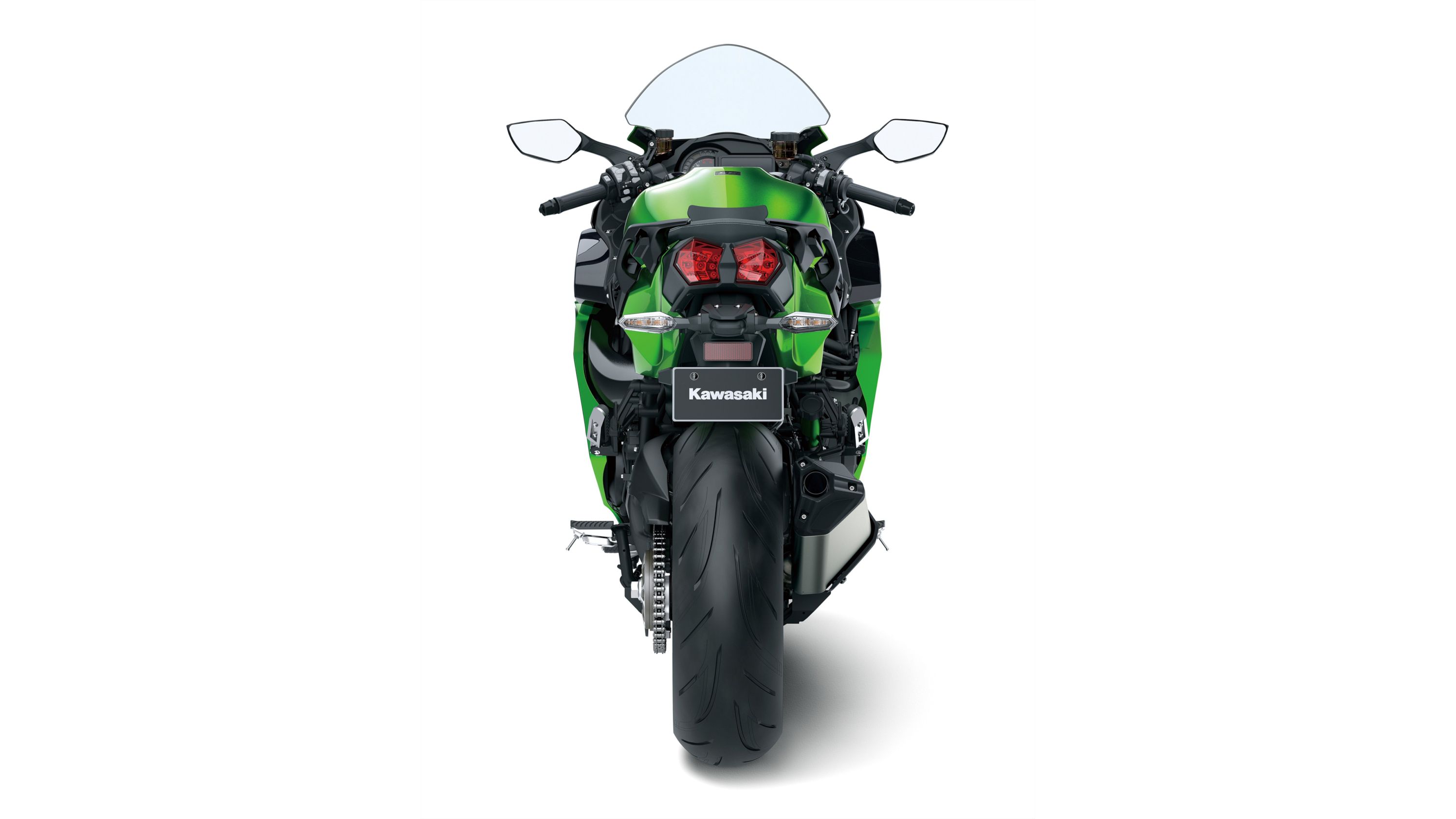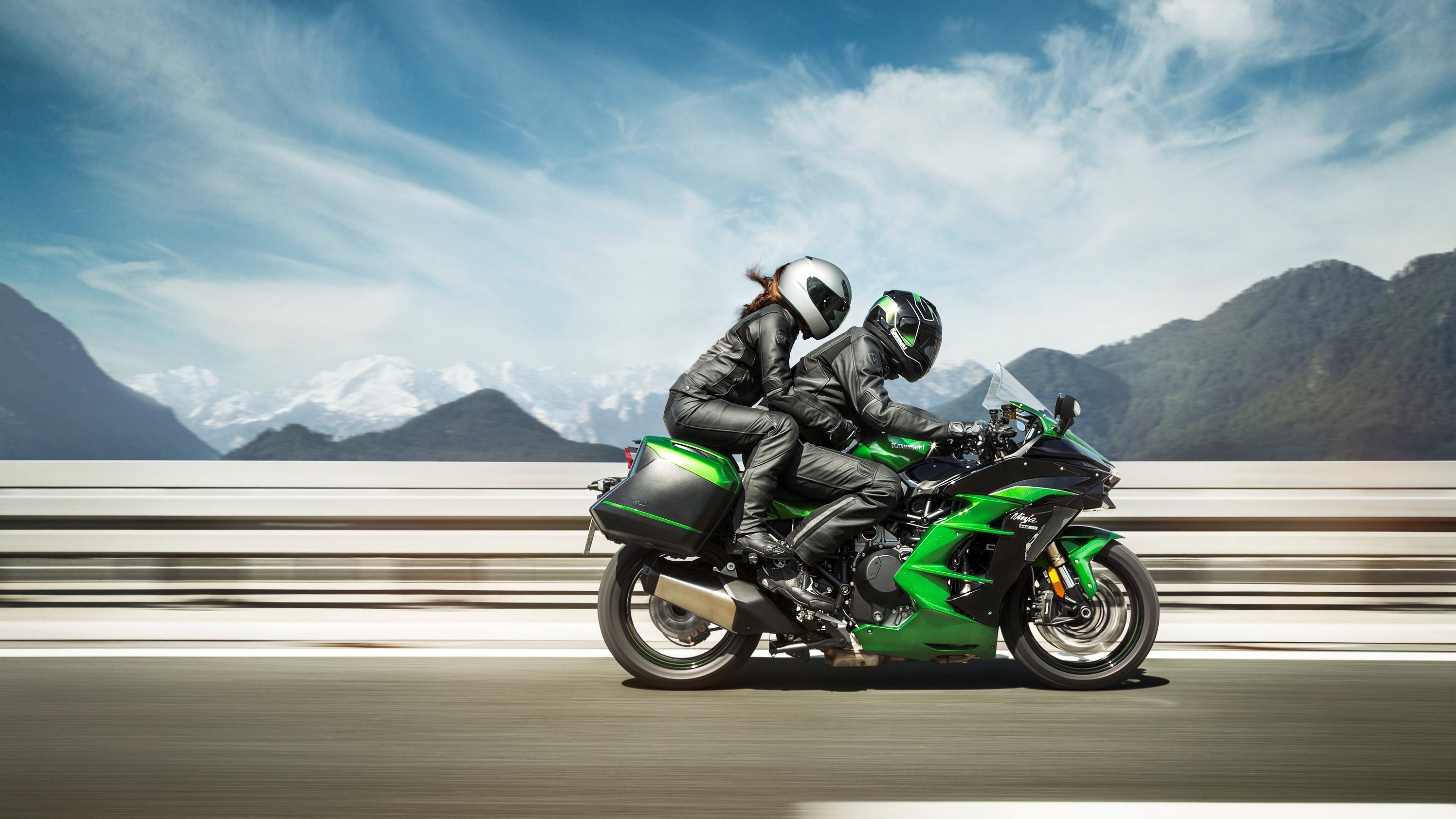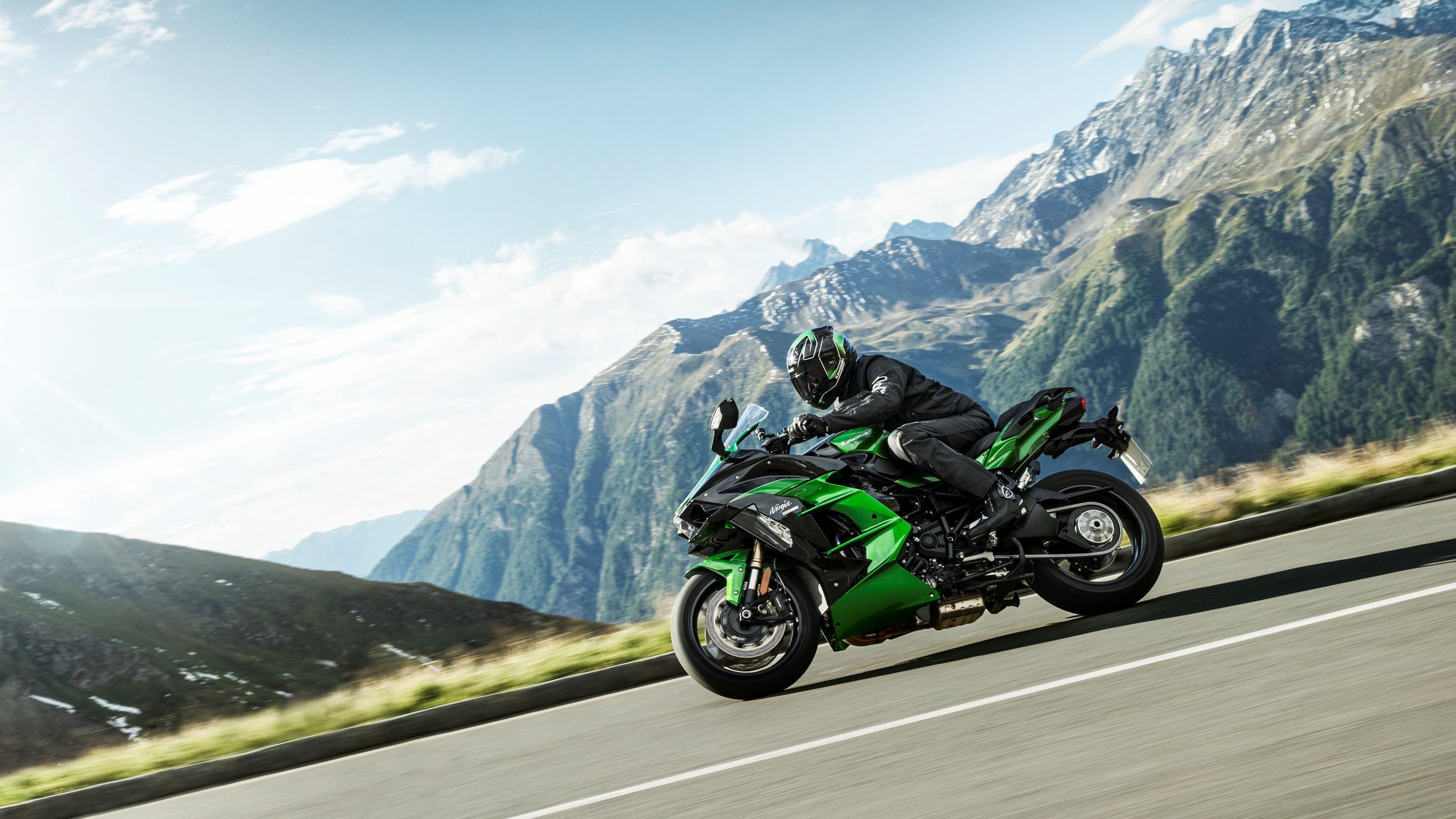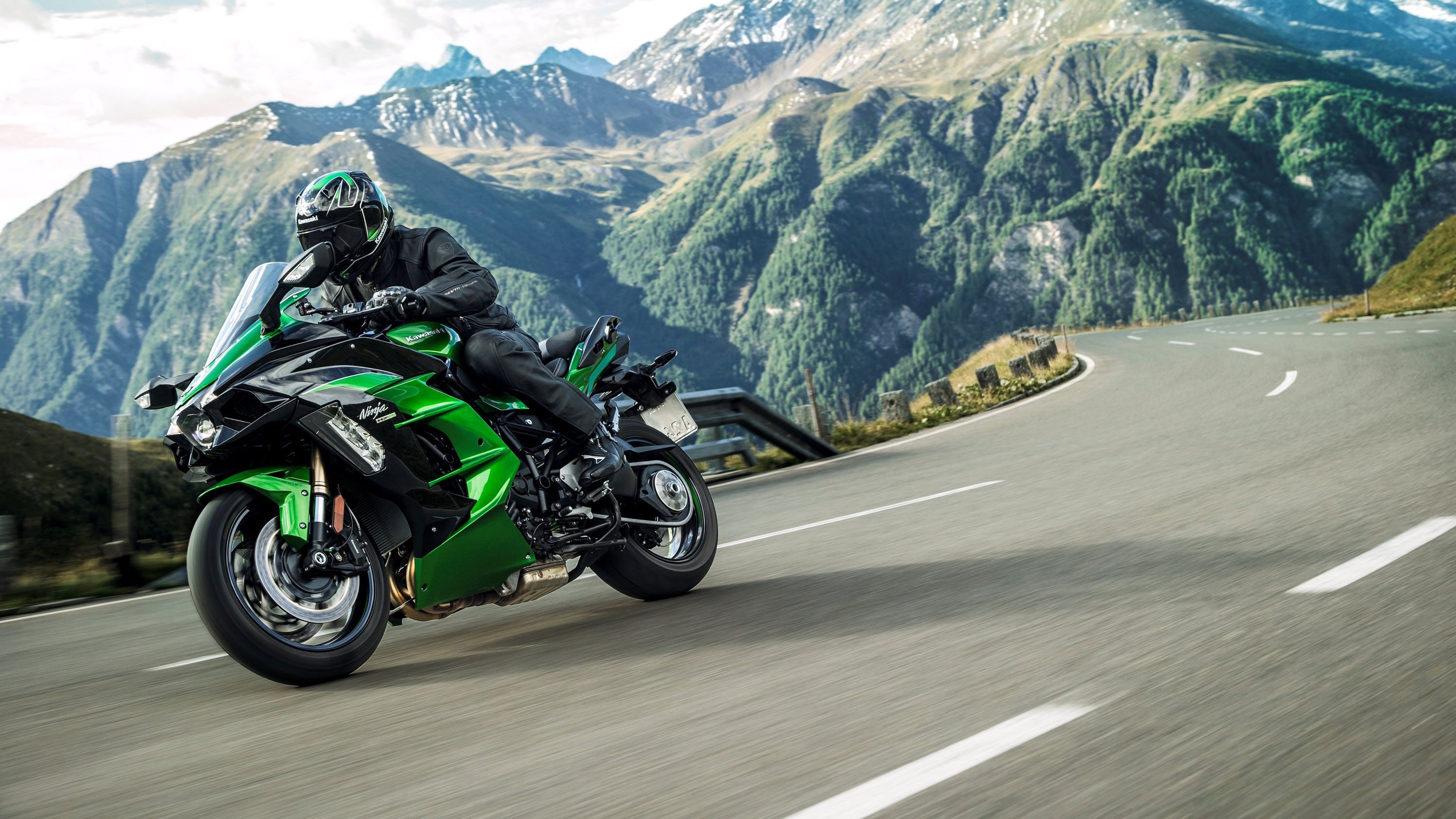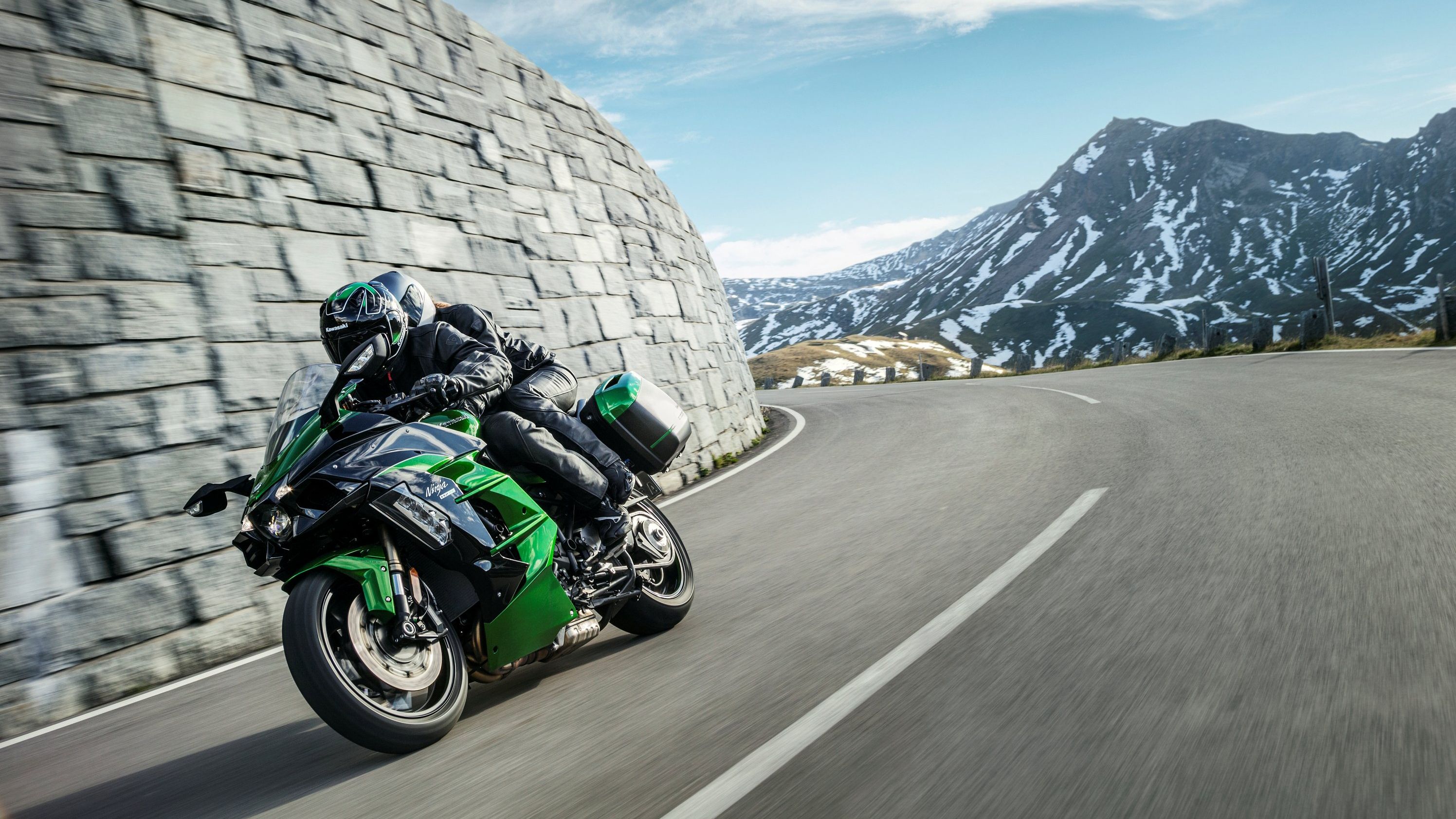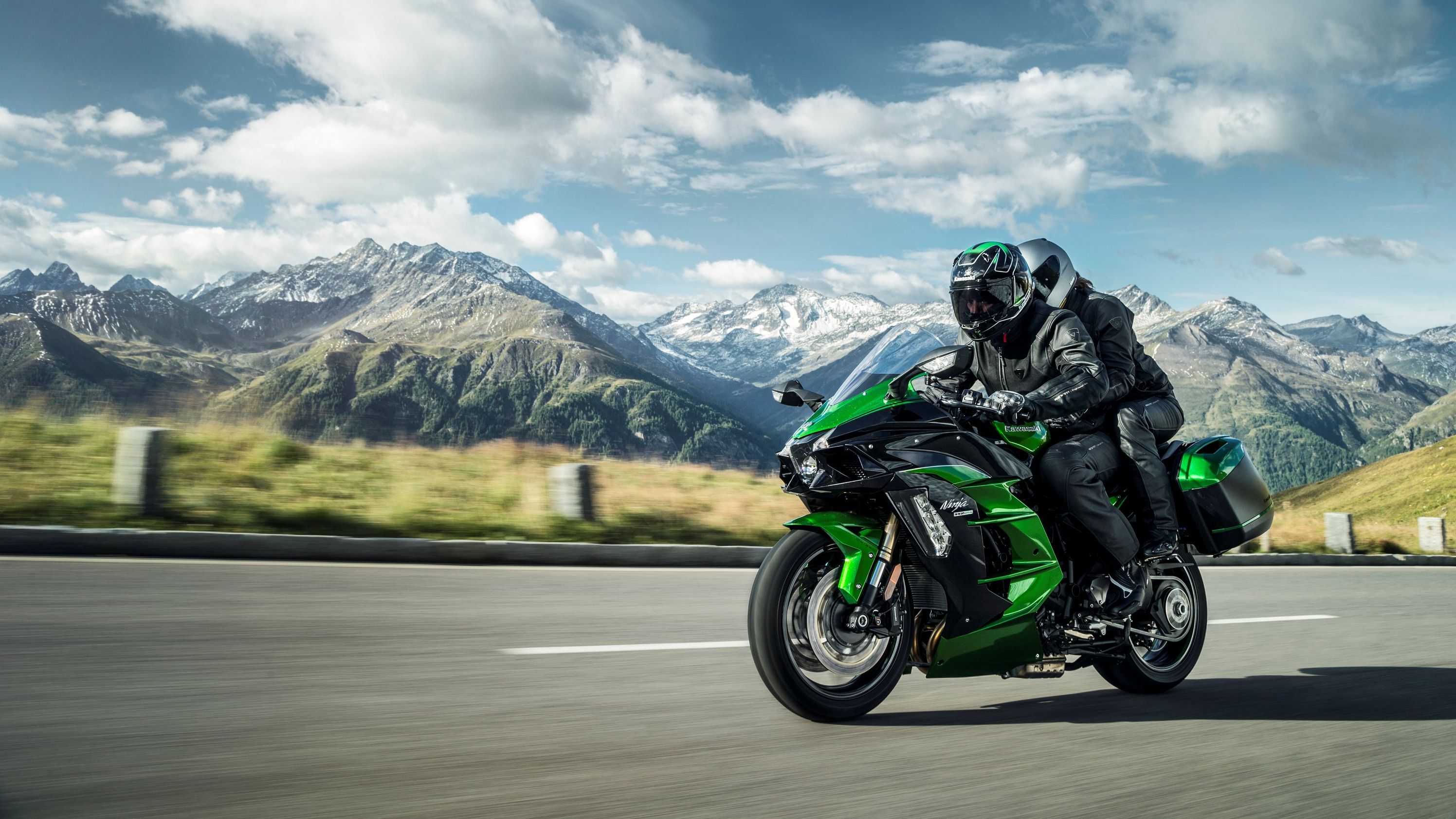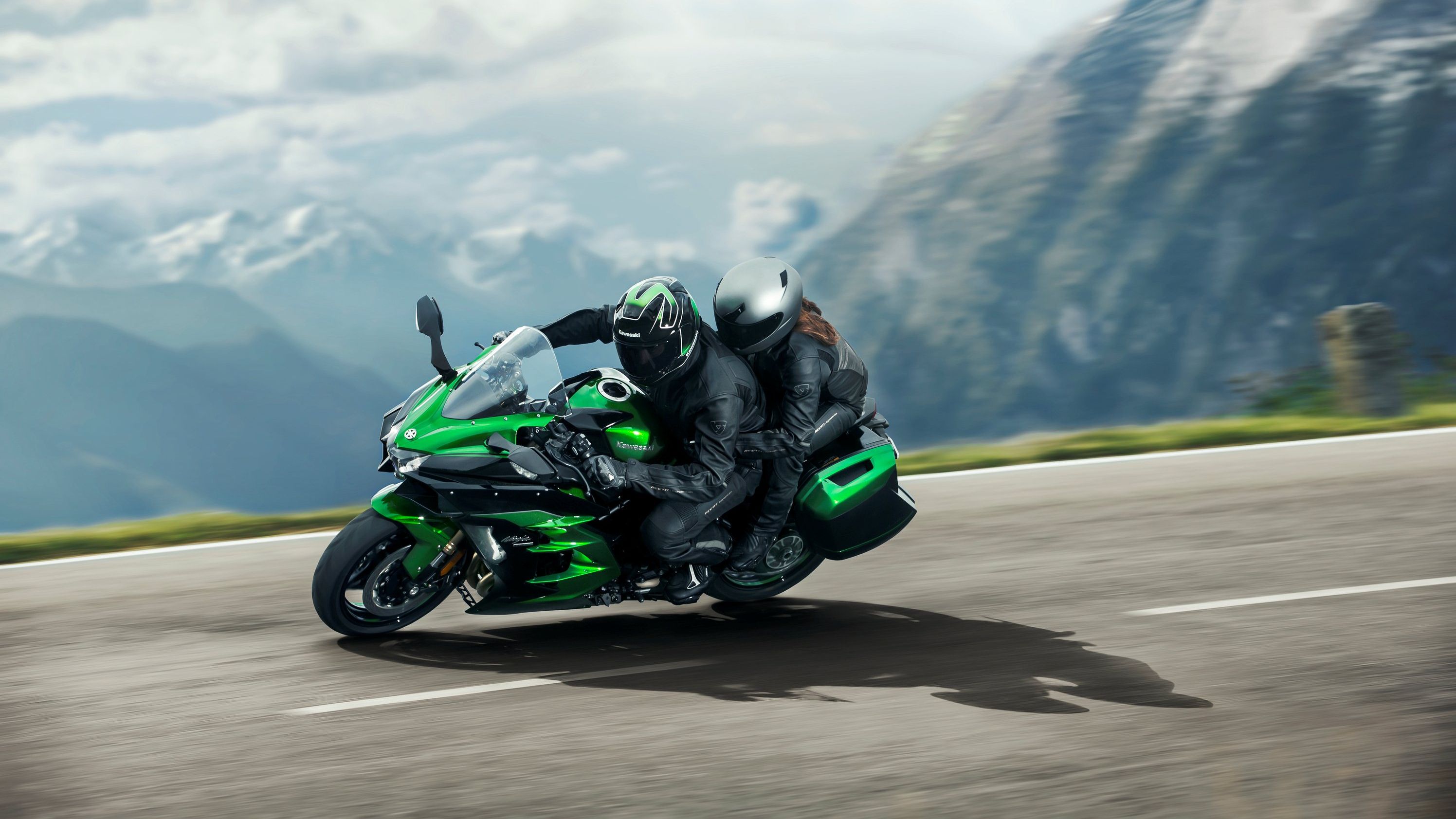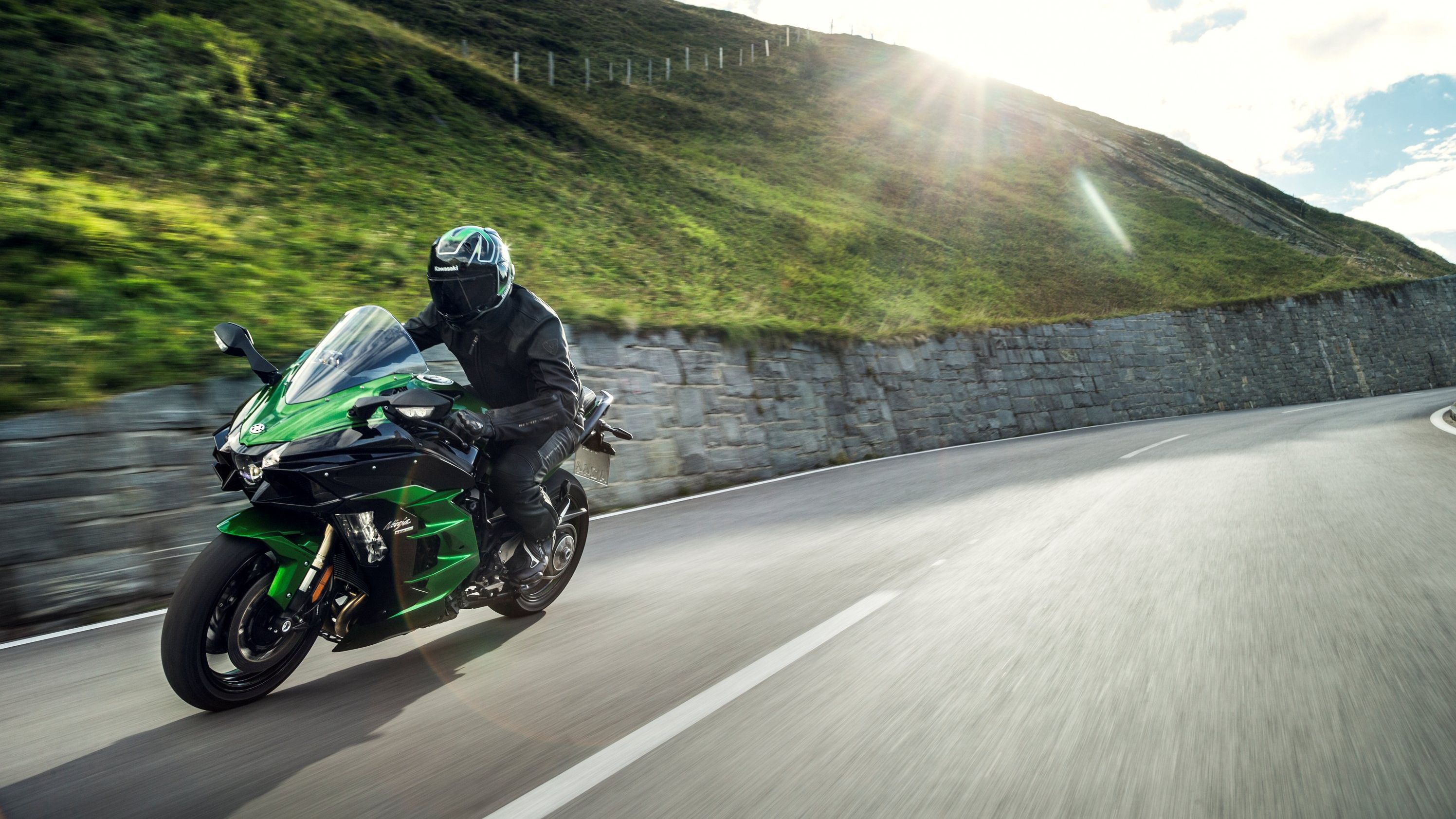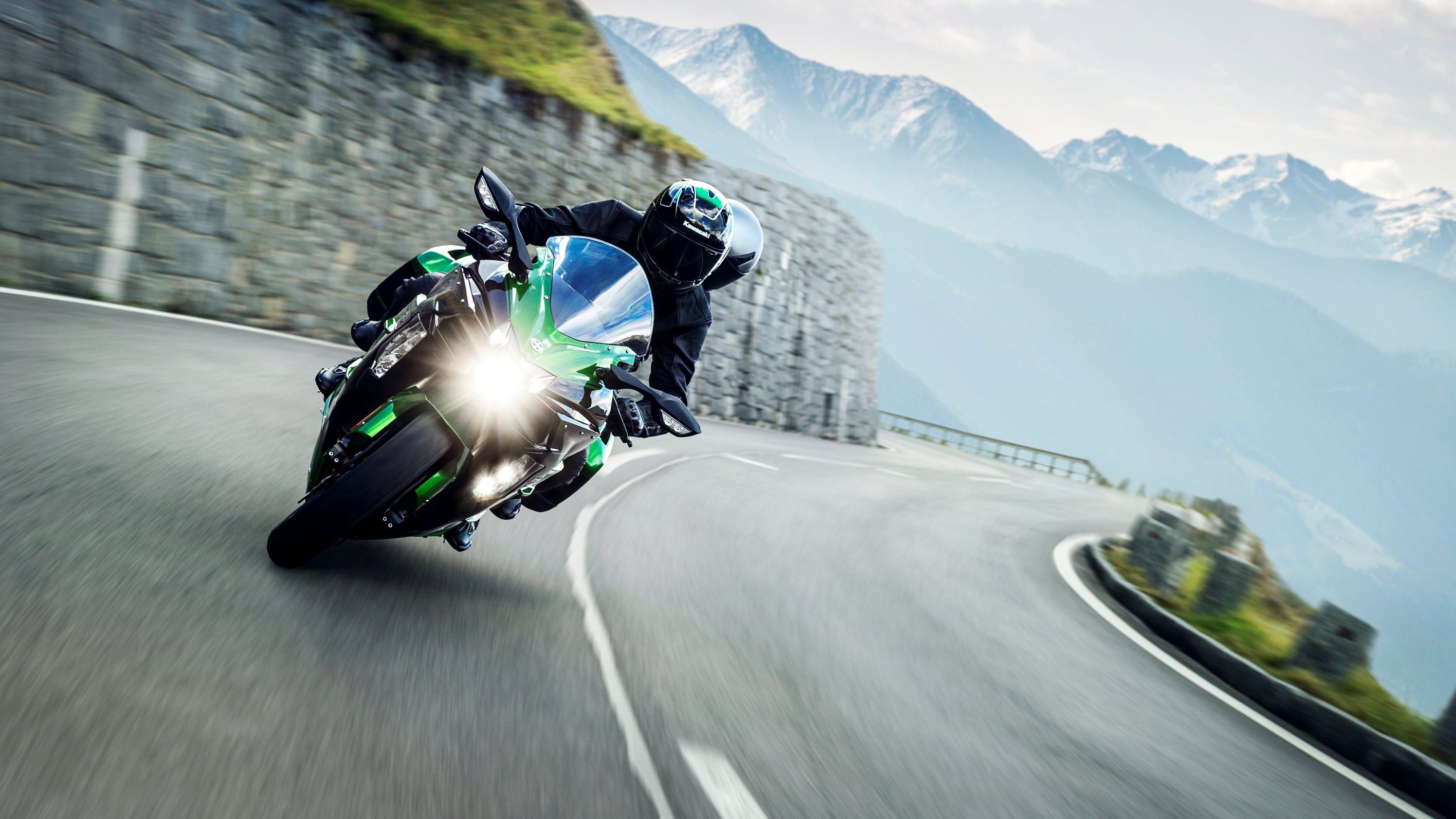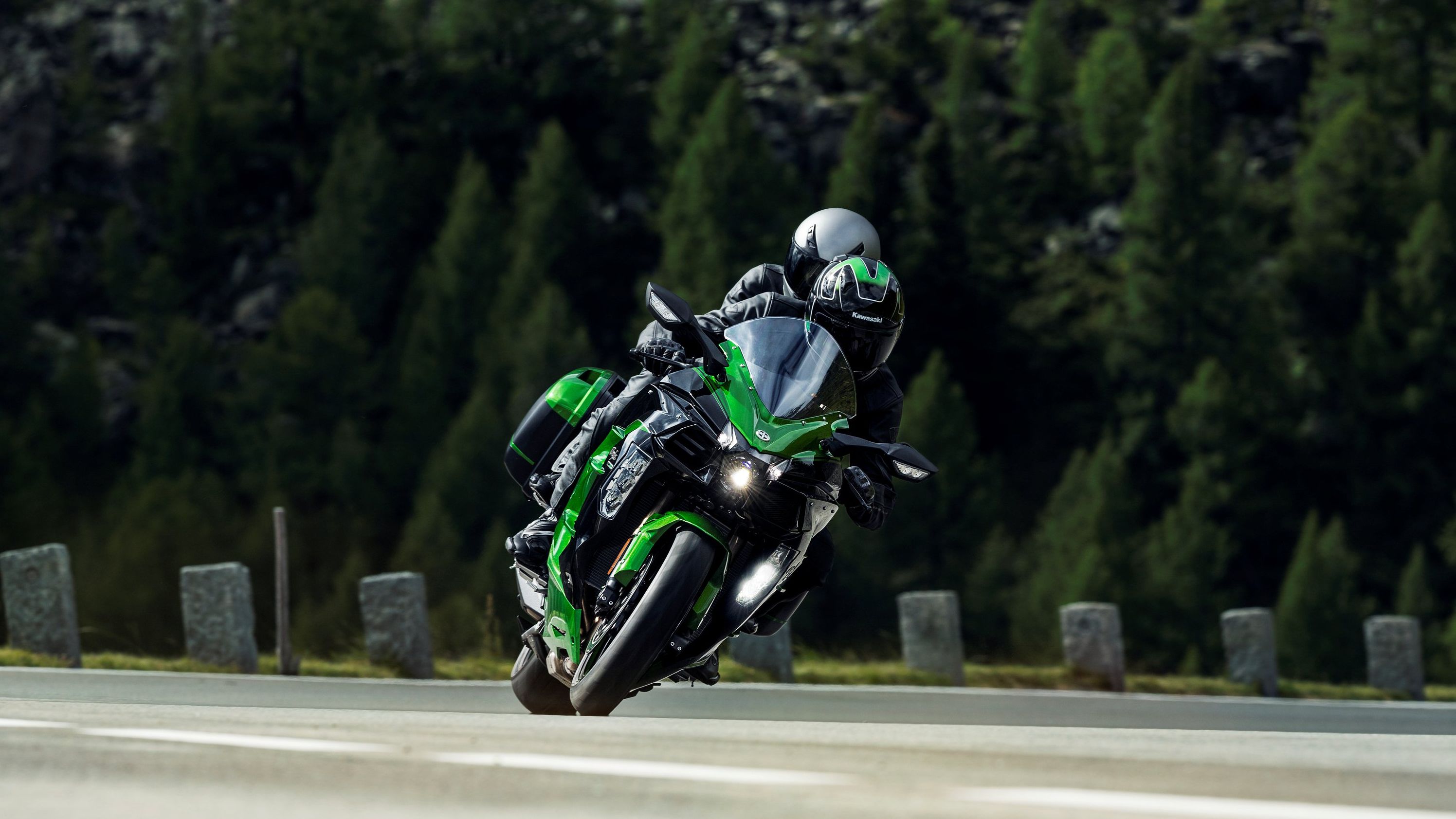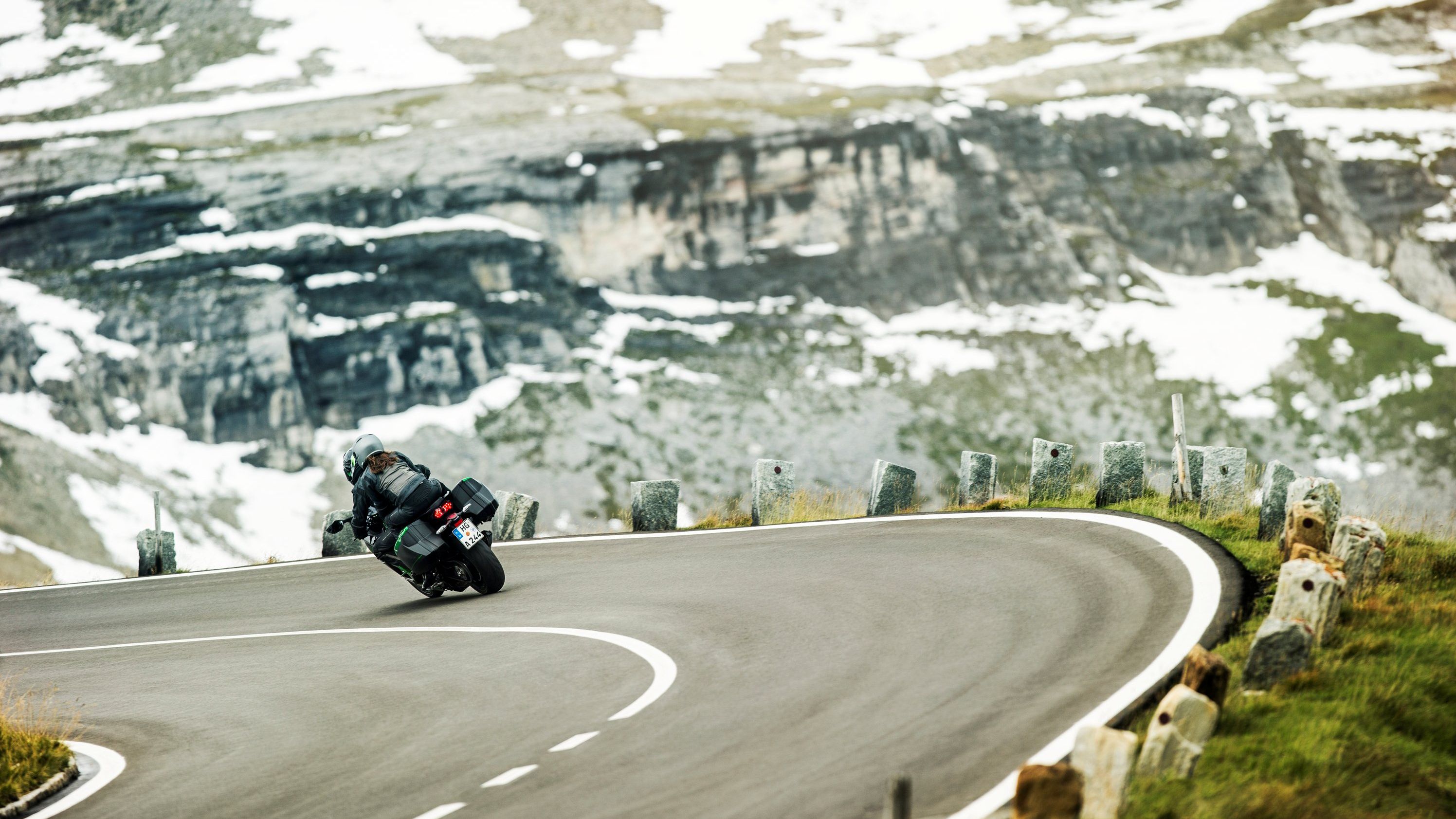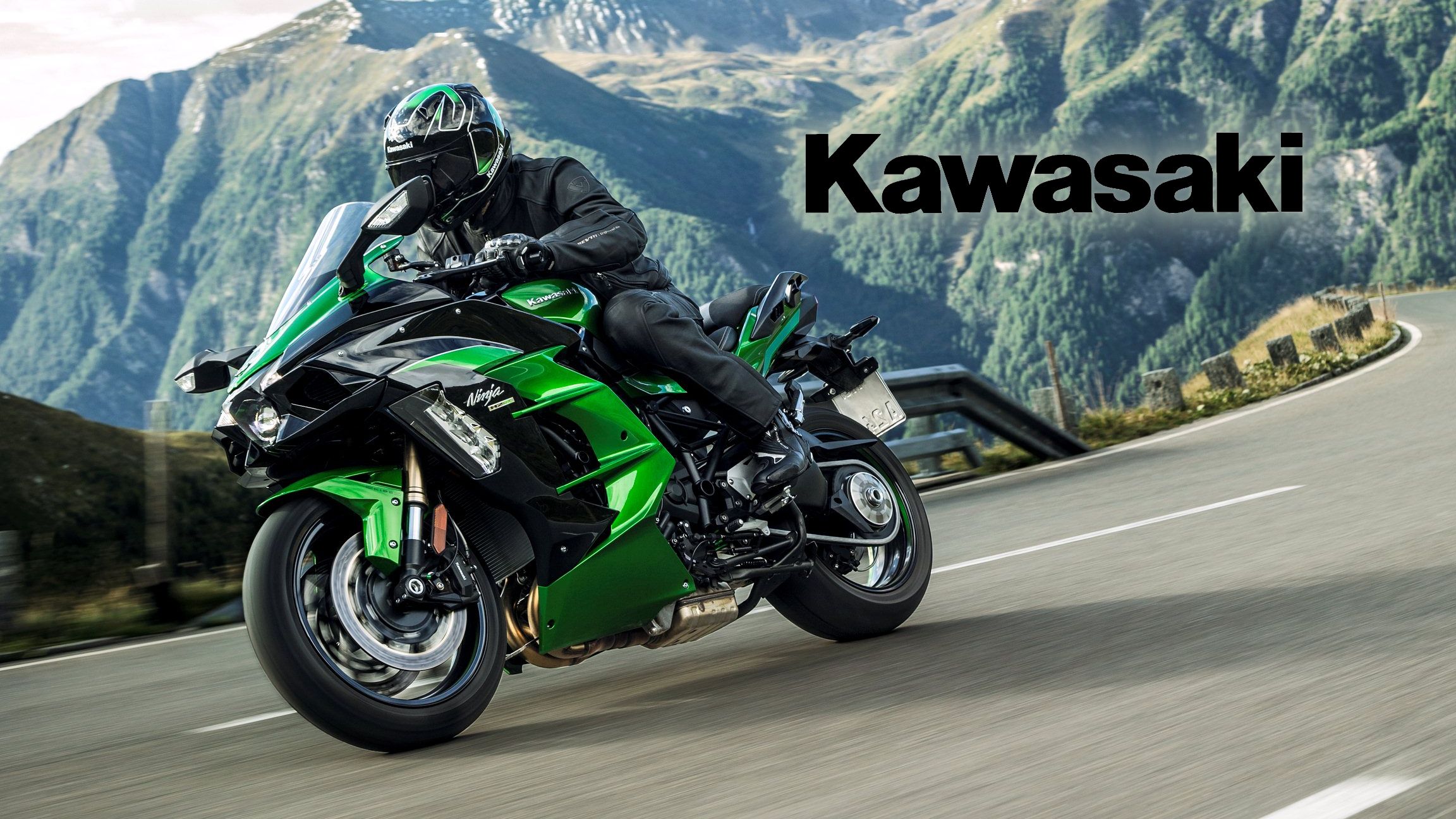Brand new in 2018, the Ninja H2 SX and H2 SX SE from Kawasaki present as a sort of hypersport-next-door with large-ish windshield and relaxed rider's triangle that is part of the comfort-oriented features package. This new line adds a dose of “super” to the sport-touring genre with its supercharged four-banger that cranks out a generous 101 pounds o' grunt with enough electronic fandanglery to help you tame the beast, or at least protect you from yourself somewhat. Commuter or 'really' fast tourbike, the SX siblings cover a lot of everyday-riding ground for riders who are looking for more than run-of-the-mill performance.
2018 - 2019 Kawasaki Ninja H2 SX / H2 SX SE
- Make: Array
- Model: 2018 - 2019 Kawasaki Ninja H2 SX / H2 SX SE
- Engine/Motor: inline-4
- [do not use] Vehicle Model: Array
Kawasaki Ninja H2 SX / H2 SX SE Design
Kawasaki's Ninja H2 made a splash when it hit the market, and if you missed the window-of-opportunity to score one of the first-run models -- or perhaps it was priced a tad out of your range -- then I have some good news for you in the form of the Ninja H2 SX and H2 SX “Special Edition.” Kawi leads the way with a futuristic-looking fairing/headlight arrangement that, in spite of all the angles and apparent impediments to flow, still manages to look fast standing still. The lowers enclose the sides of the radiator with huge vents in the cowl to help dump the waste heat.
On the SE, they mount the recessed LED cornering lights that illuminate the ground ahead of you in the turns, and come on automatically as the five-axis Bosch IMU detects the bike leaning into a turn. That little magic box does much more than this, but we'll get to that shortly.
It's safe enough to call the windshield on the base SX generous by sportbike standards, but the SE takes it up a notch (literally) with a tall peak on the screen that will make for a larger, more comfortable wind pocket for long-distance rides. Inside the screen is the instrument cluster that pairs an analog clock for the tach with an LCD display that comes with a couple of display modes: an abbreviated display for sport-type riding and a more well-rounded display for when you can take the time to study your metrics for more than a split-second at a time.
The factory offers an alternative to its thick-cushion pilot's seat with an optional saddle that drops butt-height by 15 mm, but does it at the expense of padding thickness so yeah, you get a shorter shot from hip to ground, but your butt is gonna pay for it in the long run. Though this pair rolls sans baggage, the factory snuck in some hard points for its 7-gallon, quick-release pannier system that allows you to set up either of the SX duo for touring, or maybe just a bit of grocery-getting.
A pair of J.C. handles brace the p-pad to give you a handy place to anchor a bungee net, and your passenger may appreciate a good sturdy place to grab a hold to when you start to apply the throttle. Body panels cover most of the Trellis frame, to the point that the frame is no longer part of the overall aesthetic, though the panels recede a bit below the saddle to give a tantalizing glimpse of the tubular webbing that makes up the subframe.
In back, a hangy-downy plateholder/turn signal assembly finishes out the rear end, and I gotta say this is a case where I think a hugger/tail-tidy combo would be the hot trick, 'cause I ain't feeling the mudguard look on this pair at all.
Kawasaki Ninja H2 SX / H2 SX SE Chassis
Tubular-steel members make up the Trellis frame with particular care paid to the stiffness of each one, so the frame is stiff where it needs to be without carrying unnecessary weight. The wheelbase got stretched out to 58.3-inches long and the steering arc widened to 30 degrees with a 24.7-degree rake angle and 4.1 inches of trail. This makes for easy parking-lot maneuvers and eager cornering.
An Öhlins electronic steering damper adjusts itself automatically based on vehicle speed to help you keep that front end under control at speed. Normally I wouldn't worry about such things on a bike that is meant to double as a tourer, but the supercharger is a game-changer, and this is a machine that definitely benefits from some extra control features to help manage the acceleration and potentially high top speeds.
Fully-adjustable, KYB stems support these rides, so you get all the ride control you'd expect on a race bike. Inverted, 43 mm front forks and a 40 mm gas shock sport the trinity of adjustments -- compression damping, rebound damping and preload -- and the rear shock get both high- and low-speed compression-damping tweaks.
When it comes time to haul it down, dual 320 mm discs and four-pot monobloc calipers slow the front end with a 250 mm disc and twin-pot anchor out back. Kawasaki's Intelligent anti-lock Brake System provides the safety net to prevent loss of traction due to overbraking, and the IMU sends information about the lean angle and such so the ABS can adapt to changing demands on the contact patches such as when trail-braking, etc.
The wheels are fairly standard for the sportbike genre at 17-inches around, as in the 120/70 hoop up front and 190/55 out back, and they provide a generous contact patch that is made all the more effective by the KIBS and TC features. Speed, safety and relative comfort; looks pretty good so far.
|
Frame Type: |
Trellis, high-tensile steel, with swingarm mounting plate |
|
Rake/Trail: |
24.7/4.1 in |
|
Front Suspension / Wheel Travel: |
43 mm inverted fork with rebound and compression damping, spring preload adjustability and top-out springs/4.7 in |
|
Rear Suspension / Wheel Travel: |
New Uni-Trak®, gas charged shock with piggyback reservoir, compression and rebound damping and spring preload adjustability, and top-out spring/5.5 in |
|
Front Tire: |
120/70 ZR17 (58W) |
|
Rear Tire: |
190/55 ZR17 (75W) |
|
Front Brakes: |
Dual radial-mount, opposed 4-piston monobloc calipers, dual semi-floating 320mm discs, KIBS ABS |
|
Rear Brakes: |
Opposed 2-piston calipers, single 250mm disc, KIBS ABS |
Kawasaki Ninja H2 SX / H2 SX SE Drivetrain
The real magic is in the powerplant. First, let's take a look at the nuts-and-bolts of the H2's beating heart. The transverse-mount, four-banger mill sports a 76 mm bore and 55 mm stroke for a total displacement of 998 cc and medium-hot 11.2-to-1 compression ratio that will still have you at the road-champagne pump. Dual 40 mm throttle bodies manage the induction with a pair of injectors to meter the fuel, all under the control of the ECU and RbW throttle.
The factory made a number of small adjustments to the intake tract and ports for low-resistance induction, and the cams come re-ground for a more street-friendly temperament and broader powerband that expands down into the lower rev range. Of course, the pièce de résistance is the supercharger that boosts the volumetric efficiency far beyond natural aspiration (approx. 97-percent VE) and turbocharging (up to 300-percent VE), and could potentially run as high as 700-percent VE. I doubt it's that high, the ex-compressor air temps are low enough that it doesn't even need an intercooler though it does use an aluminum chamber to bleed off compression heat.
Kawi doesn't miss a trick with the intake system. A Ram-Air intake and straight-line ducting takes advantage of the pressurized air created by forward motion, so the compressor has slightly-pressurized air to start with. Very efficient, with undeniable benefits that manifest themselves in the whopping 101 pound-feet of torque unleashed by the blower.
That's quite a bit of power to try and keep under control, but worry not dear reader. The factory gives you the tools to tailor your riding experience and the safety nets to enjoy them. A slipper clutch provides a light lever pull with its usual backtorque-limiting feature that helps prevent loss of traction during aggressive downshifts, but that apparently wasn't enough for the factory. It threw on an Engine Brake Control feature that limits the engine-braking effect for even more stress-relief for the rear contact patch.
A triple-mode TC system adds the final layer of protection, and on the Special Edition, a three-mode launch-control system prevents wheel-spin on takeoff to allow you to just go ahead and grab a fistful with impunity when you come off the light. Loads of power with the traction protection to use it with confidence? Sounds like a win to me.
|
Engine: |
4-stroke, 4-cylinder, DOHC, 4-valve, liquid-cooled, supercharged |
|
Displacement: |
998 cc |
|
Bore x Stroke: |
76.0 x 55.0 mm |
|
Compression ratio: |
11.2:1 |
|
Fuel System: |
DFI® with 40mm throttle bodies (4) with dual injection |
|
Ignition: |
Digital |
|
Transmission: |
6-speed, return, dog-ring |
|
Final Drive: |
Sealed chain |
Kawasaki Ninja H2 SX / H2 SX SE Pricing
The winning continues into the checkout line. Those familiar with the original H2, and its carbon-fiber cousin, will recall the sticker shock. Well, the prices on this pair are more reasonable with a $19,000 sticker on the Metallic Carbon Gray SX, and a $22,000 tag on the SX Special Edition in Emerald Blazed Green/Metallic Diablo Black.
|
Warranty: |
12 Month Limited Warranty (optional Kawasaki Protection Plus™ 12, 24, 36 or 48 months) |
|
Colors: |
Metallic Carbon Gray/Metallic Matte Carbon Gray (H2 SX SE: Emerald Blazed Green/Metallic Diablo Black) |
|
Price: |
$19,000 (H2 SX SE: $22,000) |
Kawasaki Ninja H2 SX / H2 SX SE Competitors
There are plenty of sport-touring bikes coming out of Europe, but I wanted to stick with something from the Big Four so I hit up Yamaha for its FJR1300ES. Decidedly un-naked, the ES sports a full front fairing complete with lowers and windshield to punch a large hole in the weather. Handlebar rise is such that, much like the H2, the rider can adopt a relatively upright posture that is more comfortable on long hauls than the sportbike/superman position.
Stock panniers make the ES tour-ready right off the showroom floor, and the overall look is pure-D sportbike. The FJR alone comes with a tuneable rider triangle courtesy of an adjustable seat and three-position handlebars, and the lux electronically-adjustable suspension pulls from the toppest (sic) of the top shelves. Unified brakes and ABS deliver similar braking performance to the H2, so I'm gonna' call it a slight advantage to the Tuning Fork Company for the push-button suspension.
At the engine compartment, the FJR sports a 1,298 cc, four-cylinder mill with TC, CC, RbW and variable power-delivery modes on board. Yammy packs in the cubeage with a much larger plant than the 998 cc Kawi, but only manages to break even with a claimed 101.8 pound-feet of torque. If that doesn't speak to the efficacy of the supercharger, I don't know what does. It will only cost you an extra grand to find out for yourself, as the FJR1300ES rolls for $17,999. To be honest, price isn't what will make or break this deal. It will come down to the supercharger on the one hand, and a slight advantage in comfort on the other.
He Said
“Well ya know, I gotta' say I'm a fan of the blower. It will wring (almost) every ounce of grunt out of the engine, and they didn't even have to add a heavy intercooler to increase the density of the charge. Nicely done, Kawi. As for the rest, the “touring” aspect is still somewhat debatable. It looks like another slightly less-uncomfortable crotch rocket to me, and doesn't even come with stock bags. I'd have thought Kawi would have learned by now.”
She Said
My wife and fellow motorcycle writer, Allyn Hinton, says, “So Kawasaki took the most ridiculously impractical motorcycle they had and made it practical. The H2 has been toned down for street use, but it's still got an insane amount of power and torque. It can handle almost twice the payload of the H2 to accommodate a passenger and gear, but then, it would have to in order to be a sport-tourer, wouldn't it? If you're interested in a touring bike and you aren't interested in seeing nothing but blurred landscape between here and your destination, the H2 SX is your Huckleberry.”
Kawasaki Ninja H2 SX / H2 SX SE Specifications
|
Engine & Drivetrain: |
|
|
Engine: |
4-stroke, 4-cylinder, DOHC, 4-valve, liquid-cooled, supercharged |
|
Displacement: |
998 cc |
|
Bore x Stroke: |
76.0 mm x 55.0mm |
|
Compression ratio: |
11.2:1 |
|
Fuel System: |
DFI® with 40 mm throttle bodies (4) with dual injection |
|
Ignition: |
Digital |
|
Transmission: |
6-speed, return, dog-ring |
|
Final Drive: |
Sealed chain |
|
Electronic Rider Aids: |
Kawasaki Corner Management Function (KCMF), Kawasaki Traction Control (KTRC), Kawasaki Intelligent anti-lock Brake System (KIBS), Kawasaki Engine Brake Control, Öhlins Electronic Steering Damper (H2 SX SE Also: Kawasaki Launch Control Mode (KLCM), Kawasaki Quick Shifter (KQS) (upshift & downshift), Cruise Control, LED Corning Lights |
|
Chassis: |
|
|
Frame Type: |
Trellis, high-tensile steel, with swingarm mounting plate |
|
Rake/Trail: |
24.7/4.1 in |
|
Front Suspension / Wheel Travel: |
43mm inverted fork with rebound and compression damping, spring preload adjustability and top-out springs/4.7 in |
|
Rear Suspension / Wheel Travel: |
New Uni-Trak®, gas charged shock with piggyback reservoir, compression and rebound damping and spring preload adjustability, and top-out spring/5.5 in |
|
Front Tire: |
120/70 ZR17 (58W) |
|
Rear Tire: |
190/55 ZR17 (75W) |
|
Front Brakes: |
Dual radial-mount, opposed 4-piston monobloc calipers, dual semi-floating 320mm discs, KIBS ABS |
|
Rear Brakes: |
Opposed 2-piston calipers, single 250mm disc, KIBS ABS |
|
Dimensions & Capacities: |
|
|
Overall Length: |
84.1 in |
|
Overall Width: |
30.5 in |
|
Overall Height: |
47.4 in ( H2 SX SE: 49.6 in) |
|
Ground Clearance: |
5.1 in |
|
Seat Height: |
32.9 in |
|
Curb Weight: |
564.5 lb ( H2 SX SE: 573.3 lbs) |
|
Fuel Capacity: |
5.0 gal |
|
Wheelbase: |
58.3 in |
|
Top Speed: |
185 mph (est) |
|
Details: |
|
|
Model ID: |
ZX1002A (H2 SX SE: ZX1002B) |
|
Warranty: |
12 Month Limited Warranty (optional Kawasaki Protection Plus™ 12, 24, 36 or 48 months) |
|
Colors: |
Metallic Carbon Gray/Metallic Matte Carbon Gray (H2 SX SE: Emerald Blazed Green/Metallic Diablo Black) |
|
Price: |
$19,000 (H2 SX SE: $22,000) |
Further Reading
Yamaha FJR1200
See our review of the Yamaha FJR1300.
Kawasaki Ninja H2/ H2 Carbon
See our review of the Kawasaki Ninja H2 / H2 Carbon.
Kawasaki
Read more Kawasaki news.


